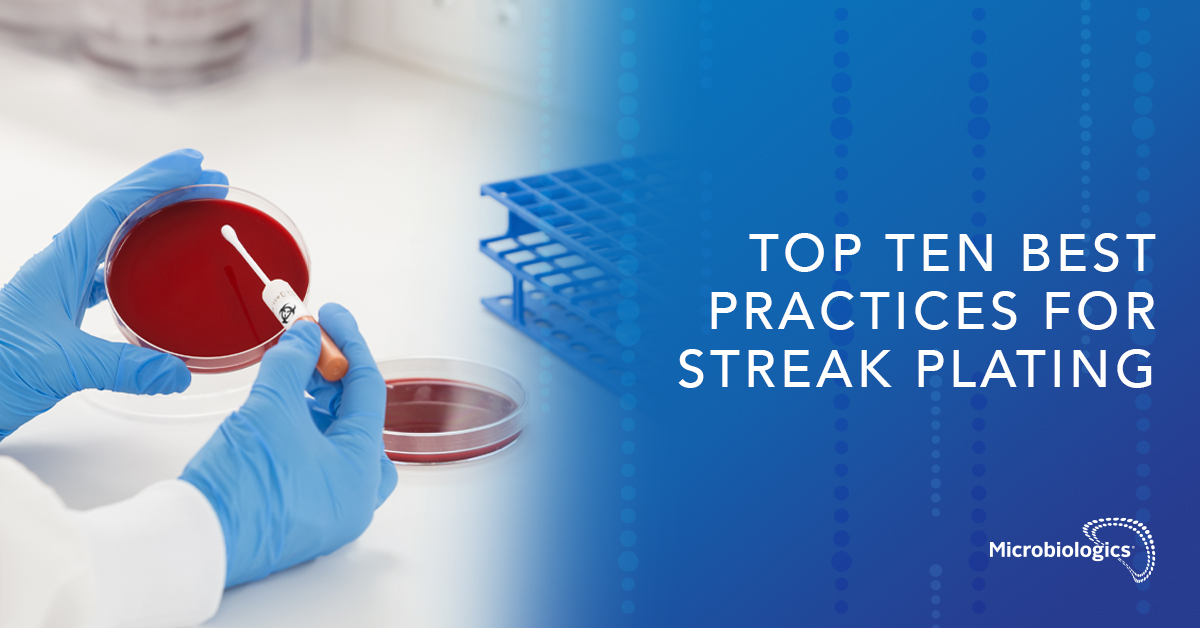Streak plating is an indispensable tool in microbiology. It is so fundamental, that it is often overlooked. We have compiled a list of best practices to help you master your technique, save time, and avoid errors in your laboratory.
The streak plate method relies on the principle of dilution to isolate individual bacterial or fungal colonies. Obtaining isolated colonies is essential to many downstream applications such as performing biochemical, genetic, or antimicrobial susceptibility testing. This technique can use many sources as an inoculum, such as Microbiologics KWIK-STIK™, a colony sub-cultured from one agar plate to another, or a cell suspension.
1. Label first, streak second. Clearly labeling your plates to identify the microorganism only takes a few seconds and will help you avoid a big headache later. Here are some common and less common labels to add to your plate.
| Common Plate Labels | Rare/Miscellaneous Plate Labels |
| Date | The type of media (if you make your own media label) |
| Organism name, catalog number, or lot number | Subculture number |
| Technician’s Initials | Special atmosphere and growth conditions (e.g., MA = microaerophilic, AN = anaerobic, CO2, etc.) |
| Growth duration of organism (for example, note the growth time if required time is longer than 24 hours) |
Instead of writing these common labels on your plate, we simplified it for you! We provide a pull-off tab on the KWIK-STIK™ device to label your media; the pull-off tab includes the organism’s name, catalog number and lot number.
For guidance on media and incubation conditions for the microorganisms you are culturing, refer to TIB.081, Recommended Growth Requirements.
2. Keep the agar dry. Make sure the agar plates are free of droplets of condensed moisture. If moisture is present, leave the plates at room temperature overnight or place them in a laminar flow hood to dry for at least 15 minutes.
3. Avoid contamination. There are many sources of contamination to be cognizant of while streak plating. Contacting the edge of the plate is a common source of contamination; therefore, avoid touching the edge of the plate with the loop while streaking or inoculating the agar with the swab. Breathing on media is another frequent cause of contamination. Observe open plates at a safe distance from your face. Although microbiologists are trained to avoid breathing on media, it remains a common cause of contamination in any laboratory. Keep your laminar flow hood and vents clean to avoid contamination as well.
4. A little goes a long way. Only a small amount of inoculum is required. Use isolated colonies if taking an inoculum from another plate or use only 5 to 10µl from a suspension. Please note that fastidious organisms (e.g., S. pneumoniae, Neisseria spp., etc.) may require a heavier inoculum. Refer to TIB.2031, Maintenance of Quality Control Strains.
5. Avoid gouging of agar. Streak lightly in smooth, rapid movements to avoid gouging the agar plate. Gouged agar won’t produce as many colonies (or look nearly as beautiful) as a carefully streaked plate. Gouging can dehydrate the plate quicker and may cause you to pick up contaminants.
6. Don’t forget to sterilize. Always use sterile equipment to spread the inoculum and avoid contamination. Flame the loop or use a new disposable loop after you streak each quadrant. Using a new or sterilized loop allows you to effectively dilute the inoculum on the plate and obtain isolated colonies by spreading the inoculum thinner and more evenly. If using a broth, sterilize your tube opening before and after use.
7. Always start by plating on non-selective agar. This helps ensure the organism is growing properly. The selective and differential media may not have enough nutrients to help the organism resuscitate after lyophilization or hydration. When plating on a selective agar in parallel or for downstream applications, remember to use quality control organisms. Exceptions may apply, please refer to the media manufacturer’s Instructions for Use.
8. Streak for colony isolation. Using a three-phase or four-phase streak will provide the best isolation. Please see below for special instructions for streak plating and the following video.
9. Incubate plates inverted. This helps avoid accumulated condensation from dripping onto colonies during incubation.
10. After incubation, examine your plate carefully. After colonies have grown, review your plate to ensure colonies meet expectations for colony morphology on the certificate of analysis. Some strains have two or more colony types which are listed on the certificate of analysis.
Streak Plating with KWIK-STIK
As mentioned, the streak plate method can be performed with Microbiologics’ KWIK-STIK™. In fact, KWIK-STIK has been praised for decades for its simple, all-inclusive design which makes life easier for laboratory technicians while reducing chances for errors. Each KWIK-STIK contains a qualitative lyophilized microorganism pellet, ampoule of hydrating fluid and inoculating swab. Everything you need to grow reference cultures for QC testing is included in this one handy device. Available in packs of 2, 6, or as a QC set, KWIK-STIKs are universally used for all types of microbiological control testing.
Please watch our Streak-Plating Best Practices with KWIK-STIK video to learn how to use this fundamental plating technique with Microbiologics KWIK-STIK product. Also, download our Streak Plate Method with KWIK-STIK illustrated instructions.






0 Comments